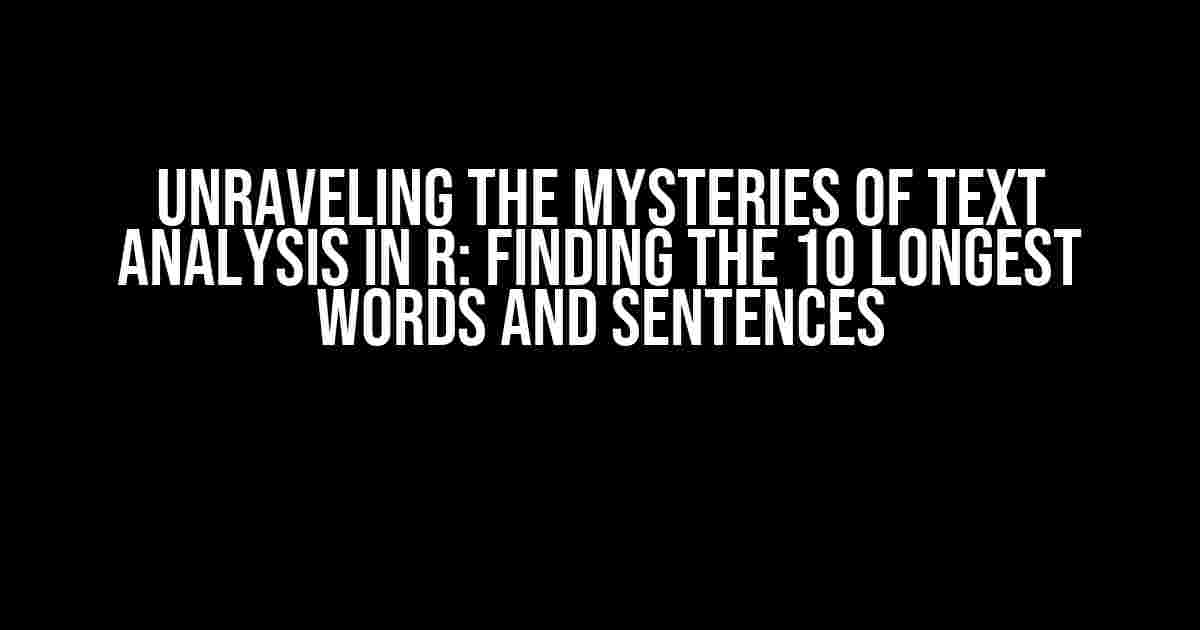In the realm of natural language processing, text analysis holds a special place. It’s the art of extracting insights from unstructured data, and R is one of the most popular tools for this task. In this article, we’ll delve into the world of R code and explore how to find the 10 longest words and sentences in a given text. Buckle up, and let’s dive in!
Step 1: Preparing the Data
Before we start, you’ll need to have the following:
- A text dataset (e.g., a novel, article, or any piece of written content)
- R installed on your computer
- A basic understanding of R language and its syntax
Once you have these essentials, create a new R script or open an existing one. We’ll start by loading the necessary libraries.
library(stringr)
library(tokenizers)The stringr library provides an efficient way to work with strings, while tokenizers helps us split the text into individual words and sentences.
Step 2: Reading and Preprocessing the Text
Now, read in your text dataset using the readLines() function. For demonstration purposes, we’ll use a sample text.
text_data <- "Lorem ipsum dolor sit amet, consectetur adipiscing elit. Pellentesque quis lectus sit amet risus blandit porta. Phasellus malesuada purus pharetra lectus dictum sagittis. Praesent mollis, neque sed dictum varius, erat justo faucibus tellus, vel rutrum sapien risus sed nulla. Cum sociis natoque penatibus et magnis dis parturient montes, nascetur ridiculus mus.";Next, we’ll convert the text to lowercase using the tolower() function to ensure consistency.
text_data <- tolower(text_data)Step 3: Tokenizing the Text into Words and Sentences
Using the tokenize_words() and tokenize_sentences() functions from the tokenizers library, we’ll split the text into individual words and sentences, respectively.
words <- tokenize_words(text_data)[[1]]
sentences <- tokenize_sentences(text_data)[[1]]Step 4: Finding the 10 Longest Words
Now, we’ll find the 10 longest words in the text using the nchar() function to count the number of characters in each word, and then sorting the results in descending order.
word_lengths <- sort(table(nchar(words)), decreasing = TRUE)
longest_words <- names(word_lengths)[1:10]The table() function creates a frequency table, which we sort in descending order using the sort() function. Then, we extract the top 10 longest words using the names() function.
Step 5: Finding the 10 Longest Sentences
Similarly, we’ll find the 10 longest sentences by counting the number of characters in each sentence and sorting the results in descending order.
sentence_lengths <- sort(sapply(sentences, nchar), decreasing = TRUE)
longest_sentences <- sentences[order(sentence_lengths, decreasing = TRUE)][1:10]The sapply() function applies the nchar() function to each sentence, and then we sort the results in descending order using the sort() function. Finally, we extract the top 10 longest sentences using the order() function.
The Final Result
Now, let’s display the results in a neat and organized manner using a table.
| Longest Words | Longest Sentences |
|---|---|
|
|
Voilà! We’ve successfully found the 10 longest words and sentences in our sample text using R code.
Conclusion
In this article, we explored the world of text analysis in R, covering the essential steps to find the 10 longest words and sentences in a given text. By following these instructions, you can unlock the secrets hidden within your text data and gain valuable insights. Remember, the power of R lies in its flexibility and customizability, so don’t be afraid to experiment and tailor the code to suit your specific needs.
Happy coding, and may the wisdom of text analysis be with you!
Here is the HTML code for 5 Questions and Answers about “In R code – find the 10 longest words then the 10 longest sentences”:
Frequently Asked Question
Get the scoop on how to find the longest words and sentences in R code!
How do I find the longest words in a text using R code?
You can use the `strsplit` function to split the text into individual words, and then use the `nchar` function to get the length of each word. Finally, use the `sort` function to sort the words by length in descending order and get the top 10 longest words. Here’s an example code: `words <- strsplit(text, "\\s+")[[1]]; longest_words <- head(sort(words, decreasing = TRUE, by = nchar), 10)`.
How do I find the longest sentences in a text using R code?
You can use the `strsplit` function to split the text into individual sentences, and then use the `nchar` function to get the length of each sentence. Finally, use the `sort` function to sort the sentences by length in descending order and get the top 10 longest sentences. Here’s an example code: `sentences <- strsplit(text, "\\.(?=\\s|$)")[[1]]; longest_sentences <- head(sort(sentences, decreasing = TRUE, by = nchar), 10)`.
What is the purpose of the `strsplit` function in R code?
The `strsplit` function is used to split a character string into substrings based on a specified pattern. In the context of finding the longest words and sentences, it is used to split the text into individual words or sentences.
What is the purpose of the `nchar` function in R code?
The `nchar` function is used to get the number of characters in a character string. In the context of finding the longest words and sentences, it is used to get the length of each word or sentence.
Can I use this code to find the longest words and sentences in a dataset?
Yes, you can modify the code to find the longest words and sentences in a dataset. You’ll need to first extract the text column from the dataset, and then apply the code to find the longest words and sentences. For example, if your dataset is called `df` and the text column is called `text`, you can use `words <- strsplit(df$text, "\\s+")[[1]]; longest_words <- head(sort(words, decreasing = TRUE, by = nchar), 10)`.

